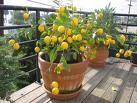Growing great Lemons.
Citrus trees which include Lemons, Oranges, Limes, Mandarins, Kumquats and Grapefruit, are attractive shrubs or trees with glossy green leaves that are aromatic, have fragrant flowers and plentiful fruit. Once relegated to the back corner or the vege patch they are now being used as feature plants, informal screening or as pot specimens.
If you only have space for one Citrus tree, you should plant a ‘Meyer’ Lemon. This is the most popular variety for the home garden as they are naturally a smaller grower with thorn-less branches and in favourable conditions can fruit almost all year round. Within two years you should have a continuous supply of Lemons. The ‘Meyer’ variety is the hardiest of all Lemons but should be protected from heavy frosts when young. The Lemon is a classic plant and deserves to be planted in every garden. The Fruit is essential for those G & T’s, water jugs and the many cooking uses.



Growing Citrus in Pots
Almost all citrus will fruit when grown in pots and Lemons and Limes will grow particularly well. This is a great way of having the fruit handy and of getting around difficult growing conditions. The important thing is to follow the guidelines below for feeding and especially watering. If well feed they will last several seasons before needing to be re-potted. They can be potted back in to the same pot if the mix is shaken off and the roots and foliage given a prune.
Planting
When choosing a spot to plant your Citrus you need to consider the following:
- Sunshine: Perhaps the most important thing. Lemons need as much sun as possible to be able to flower.
- Drainage: While Lemons love to be watered it is important to find a spot that drains well. This means they do well in sandy soils as long as plenty of compost and other organic material are dug through. Citrus is prone to collar and root rots in wet soils.
- Position: If protected from salt- ladened winds they will grow reasonably well in coastal conditions. As long as the frosts are not too heavy they will also handle cooler climates. Lemons will harden as they age and ‘Meyer’ is an excellent choice for cooler locations.
Watering
Citrus trees have a shallow root system so in dry periods need regular watering, especially to encourage flower and fruit development. If the fruit starts to drop before it is ready, it is generally a sign of uneven watering. This can also be caused by a lack of fertiliser.
A good application of mulch in summer will help retain soil moisture and prevent drying out which can lead to premature fruit drop. It is common for a certain amount of flower and fruit drop to occur when trees put on growth spurts during the warmer months.
Feeding
Citrus trees are generally flowering or fruiting or both most of the year and as such are gross feeders. Because of this it is important to keep up with regular feeding. There are many suitable Citrus or all purpose fertilisers available and applications in early spring and mid-summer will carry the tree through.
Adding blood and bone or a liquid fertiliser once a month during spring and summer will keep the leaves a healthy and glossy green and help produce juicy fruit.
Spraying
- Spray citrus with a copper spray in spring at petal fall and again three weeks later to prevent veruccosis or scab. Veruccosis is a scabby, wart-like growth on the fruit, and can appear on the tree. While it does not affect the taste of the fruit, it does have an unsightly appearance.
- Apply spraying oil in winter to control mites, mealy bug and scale insect.
- In spring and summer, spray trees with an insecticide to control mites and aphids as necessary. Aphids are attracted to the soft new growth in spring.
- Citrus can become covered in a black mould, which can be controlled with a suitable fungicide. A well fed tree kept clear of insects should be less prone to it.
- The same controls should be used for citrus leaf miner. This is the larvae of a moth and tell tale signs are a silvery trail as they eat their way through the leaf.
While this seems like a lot of work it is really only an occasional spray if required. Generally strong and healthy trees help repel pests and diseases. The most important parts of this regime would be the copper and an insecticide in spring.
Pruning
 Pruning is not generally required but it can be done to control the size and shape of the tree. A light prune is best and should be done after fruiting has finished. Fruit forms on the new season’s growth so if pruned too hard the tree may not flower for a few seasons.
Pruning is not generally required but it can be done to control the size and shape of the tree. A light prune is best and should be done after fruiting has finished. Fruit forms on the new season’s growth so if pruned too hard the tree may not flower for a few seasons.
If you have a grafted tree, remove any shoots that sprout from below the graft, as this is the rootstock. It is distinctly different, being dark green and thorny and if left unchecked will eventually take over.
Handy hint: When your plants are young it pays to pick off any fruit that begins to develop. The plant will use a lot of nutrients and energy to make the fruit so by removing them all that energy will go into new growth and make a bigger and stronger tree. And don’t worry, within a couple of years you will have more Lemons than you know what to do with.
Do you need to pee on them?
There will many of you who are reading this thinking ‘What?’ as well as a good portion who are sitting there nodding their heads and who would swear by this treatment. While it is a bit of an old tale, it stems from the acidity needs of Lemons. So while you don’t need to do this and can now use a range of modern fertilisers there is no harm from using the tree as the male pit stop at your next BBQ. Who knows? Maybe it does work and will give you better Lemons. Let us know…….